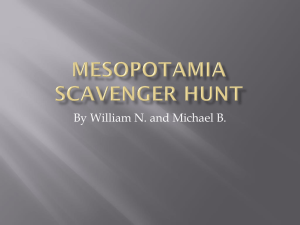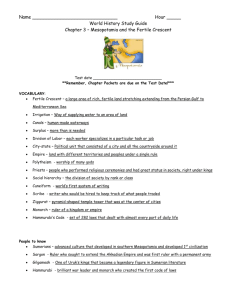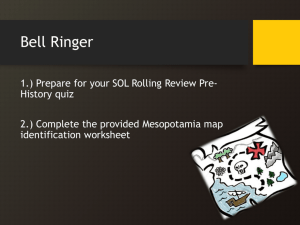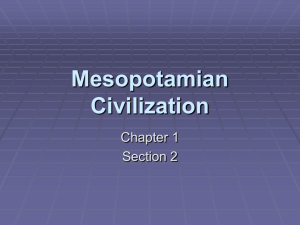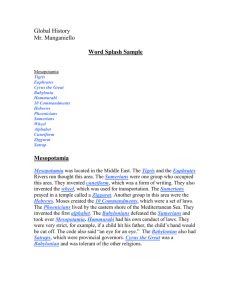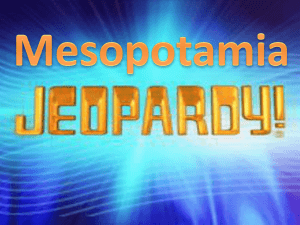unit 3 study guide slides
advertisement
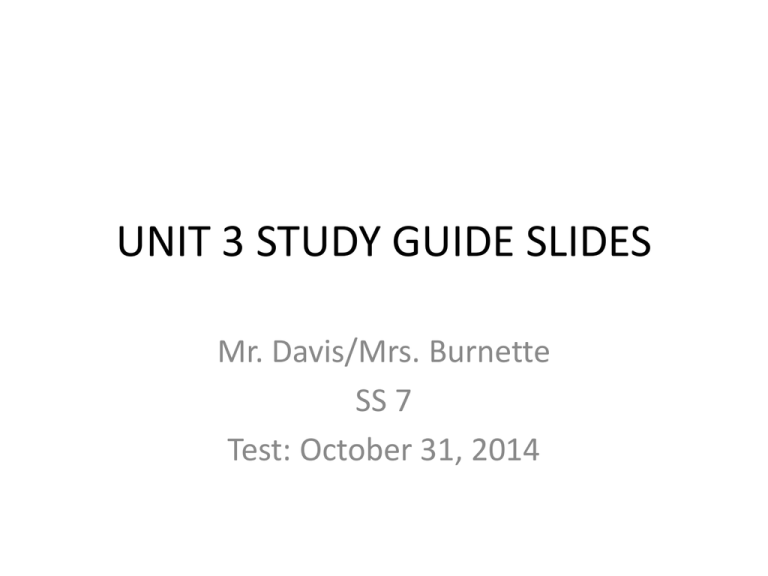
UNIT 3 STUDY GUIDE SLIDES Mr. Davis/Mrs. Burnette SS 7 Test: October 31, 2014 Remember!!! • You should be able to define ALL vocabulary words located on Pages 2 & 3 of your Interactive Notebook. • 15 matching questions on this test! 1. Where is Mesopotamia located…? • Mesopotamia is located in a region of the Middle East known as the FERTILE CRESCENT. • It is in modern-day IRAQ. • It’s name is Greek for “between the rivers” • Located between the TIGRIS and EUPHRATES Rivers 2. Why did people settle…? • The rivers provided rich silt deposits that made farming in the region easy. 3. List the events that allowed Mesopotamia to develop… • People settled where crops would grow, then the population would grow (b/c people had enough food to be healthy), and then villages formed. 4. What is division of labor? • Division of labor is a specialization of work. People would learn to become craftsmen because not everybody had to farm or raise food in order to survive. 5. What was the purpose of canals? • Sumerians needed a way to control the river’s flow for the crops in their fields and the pastures their livestock would graze 6. Why did city-states fight each other? • Each city-state wanted to have enough farmland to grow food to feed their growing populations. 7. Why is Sargon… important? • He is the first ruler to have a permanent army. 8. How did Ancient Sumerians protect themselves? • They built thick walls around the city-state to keep invaders out and citizens safely inside. 9. What role did the priests serve in society? • They served as a messenger or “middle man” between the Sumerians and their gods. 10. Draw the social pyramid and label each class KINGS PRIESTS TRADERS/CRAFTSMEN/SCRIBES FARMERS & LABORERS SLAVES 11. What job allowed… move up in society? • SCRIBES were able to read and write, which made them very important, especially to governments and temples. 12. Describe cuneiform • A form of writing using wedge-shaped symbols • Scribes would use a stylus on wet clay to keep records 13. How did Sumerians practice medicine? • Sumerians recorded all of their observations • They used natural resources to create healing drugs • Among these are milk, turtle shells, figs, and salt • Treatment was based on symptoms and body parts 14. Describe ziggurats and their purpose • Ziggurats were tall temples built in the center of Sumerian cities • They were constructed to honor the gods 15. Describe a cylinder seal and its purpose • Cylinder seals were a lot like a modern signature stamp • They were artistic, but were rolled over wet clay to “sign” documents • They were also used to mark property 16. Who was the first king of Babylon? • Hammurabi 17. What did he create…? • Hammurabi’s Code – A set of 282 laws that dealt with every aspect of daily life • Every crime had a punishment to go with it • Social class mattered • Most thorough set of laws displayed for the people to see in ancient history. 18. What are the Hittites known for? • Their skill in ironworking to make weapons • Their early use of the chariot as a weapon of war. 19. What are the Kassites known for? • Lived north of Babylon • Assassinated the Hittite King • Ruled afterward for 400 years 20. What do the Hittites and Assyrians have in common? • They both were skilled with iron weapons and chariots in battle. 21. What are the Chaldeans most remembered for? • King Nebuchadnezzar and the Hanging Gardens • Rebuilding Babylon • Culture: Rebuilt Sumerian Temples, Tributes to Sumerian gods • Education: Astronomy & Geometry, Calendar 22. What do Hammurabi and Nebuchadnezzar have in common? • They both were kings that built up Babylon. Hammurabi with his code of laws. Nebuchadnezzar with the Hanging Gardens. 23. What is different about the Phoenicians…? • The Phoenicians were not invaders of the Fertile Crescent. • They attained wealth and power through trade. • Traveled by sea 24. What did Phoenician traders… spread? • The Phoenician alphabet spread along trade routes as scribes recorded the goods being shipped across the Mediterranean 25. Political Units set up by Phoenicians? • The Phoenicians established colonies to trade resources such as silver, ivory, and slaves REMINDERS… • KNOW YOUR VOCABULARY (15 matching questions) • KNOW THE SOCIAL HIERARCHY (3 questions) • BE ABLE TO READ AN ARTICLE AND ANSWER QUESTIONS (5 questions)

